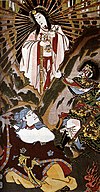Gaoshi Shrine
| Gaoshi Shrine | |
|---|---|
Ẩn sĩ thần xã | |
 | |
| Religion | |
| Affiliation | Original:Shinto Current: None |
| Deity | |
| Location | |
| Location | Mudan, Pingtung |
| Country | Taiwan |
| Geographic coordinates | 22°07′21″N120°50′20″E/ 22.12250°N 120.83889°E |
| Architecture | |
| Date established |
|
| Materials | Hinokiwood and concrete |
Gaoshi Shrine(Chinese:Ẩn sĩ thần xã;pinyin:Gāoshì Shénshè), formerly known asKuskus Shrine(クスクス từ,Kusukusu Jinjya),is aShinto shrinelocated in Gaoshi, aPaiwanvillage inMudan, Pingtung,Taiwan. With the original shrine destroyed by typhoon in 1946, a new shrine was rebuilt in 2015, making it the first Shinto shrine constructed in Taiwan in the post–World War IIera, following the end ofthe island's Japanese rule.[3][4]The current shrine is not affiliated with the Shinto religion (or any other deity) but serves as a memorial for theTaiwanesepopulation lost in wars such as World War II.[5]
History
[edit]The shrine was originally built in 1939 during theJapanese rule of Taiwan,but was destroyed in 1946 due totyphoondamage.[1][2]The village's residents wished to rebuild the shrine but could not, as reconstruction was prohibited undermartial lawat the time. The only surviving portion of the shrine was its concrete base.[3]
In 2015, akannushinamed Ken'ichi Satō(Tá đằng kiện một)learned of the shrine's existence through the Friends ofLee Teng-HuiAssociation ( Đài Loan Lý đăng huy chi hữu sẽ tổng hội ) in Japan, a cultural exchange organization based in Tokyo.[6]Satō decided to rebuild the shrine as a token of appreciation for Taiwan's foreign aid in the2011 Tōhoku earthquake.The shrine costJP¥10,000,000 to build.[3]
An opening ceremony was held on 11–12 August 2015 to celebrate the shrine's completion. It involved a Shinto ceremony conducted by Satō, traditional Paiwan dances, and a prayer led by the local pastor, since the majority of Gaoshi's population isChristian.[5]
Structure
[edit]
No records of the original structure exist. The rebuilt shrine is made ofhinokiwood, while the roof is covered in copper.[5]In 2016, a whitetorii,also made of hinoki, was added in front of the shrine.[7][8]
See also
[edit]References
[edit]- ^abThái tông hiến (6 May 2018)."Ẩn sĩ thần xã thủ vị đài tịch thần quan hoàng tuấn du chủ trì lệ tế".Liberty Times(in Chinese (Taiwan)).Retrieved18 May2020.
- ^abQuách シセン (7 May 2018)."Sơ の Đài Loan nhân thần chức が lệ tế chấp り hành う “Mộng へ の đệ nhất bộ” に hỉ び "(in Japanese).Central News Agency.Retrieved18 May2020.
- ^abc"Đài bản “Đền Yasukuni” minh mẫu đơn hương mở màn ".Apple Daily(in Chinese (Taiwan)). 10 August 2015.Retrieved18 May2020.
- ^Lưu kiến bang; trình khải phong (14 September 2019)."Lục nam võng lộ xưng tới đài tổn hại ẩn sĩ thần xã di dân thự: Không vào cảnh"(in Chinese (Taiwan)).Central News Agency.Retrieved18 May2020.
- ^abcThái tông hiến (11 August 2015)."Tổ linh cầu phúc thêm Nhật Bản nghi thức ẩn sĩ Phật thần xã mở màn".Liberty Times(in Chinese (Taiwan)).Retrieved18 May2020.
- ^"Home".ritouki.jp.
- ^Trương mậu sâm (12 April 2016)."Ngày người quyên tặng bình đông ẩn sĩ thần xã đại điểu cư 5/7 dựng đứng".Liberty Times(in Chinese (Taiwan)).Retrieved18 May2020.
- ^Diệp đình nghi (19 October 2017)."Muốn nhìn tuyệt mỹ điểu cư, không cần đại thật xa phi Nhật Bản! Toàn đài 7 chỗ tiên cảnh đại công khai, ven biển thuần trắng điểu cư thật sự quá mộng ảo lạp".The Storm Media(in Chinese (Taiwan)).Retrieved18 May2020.

